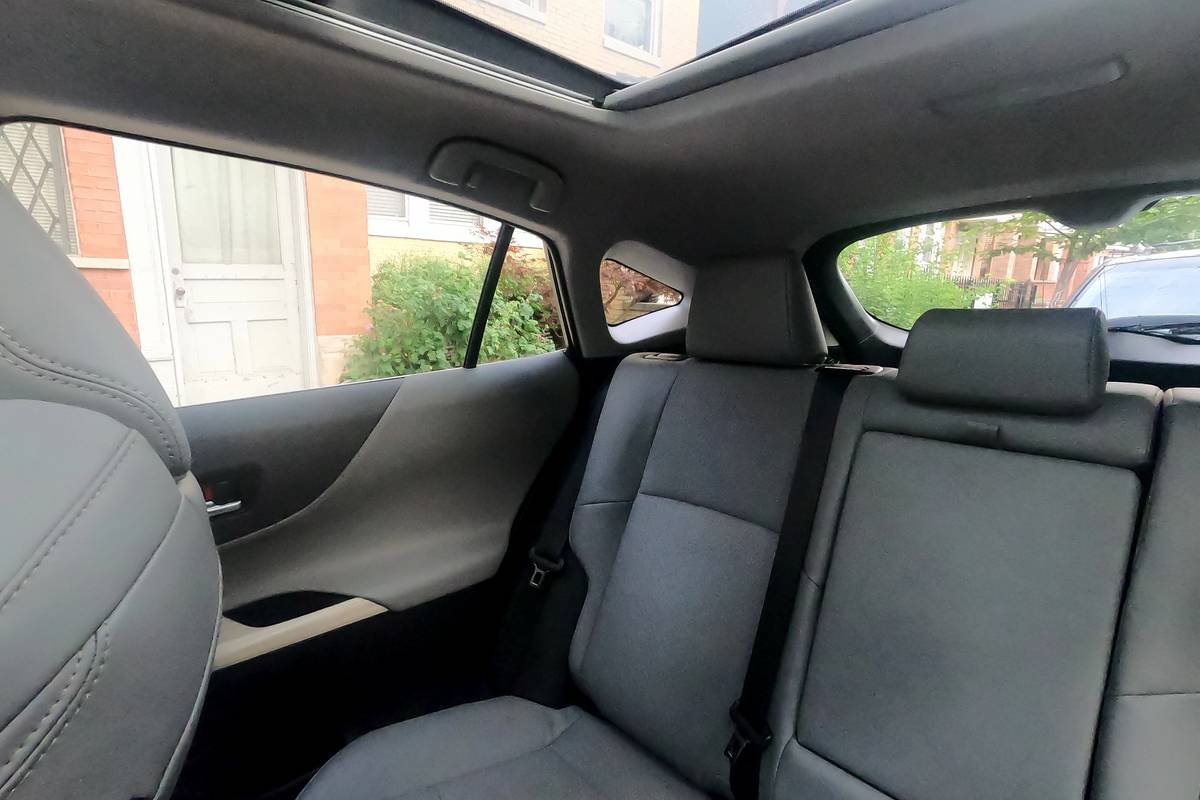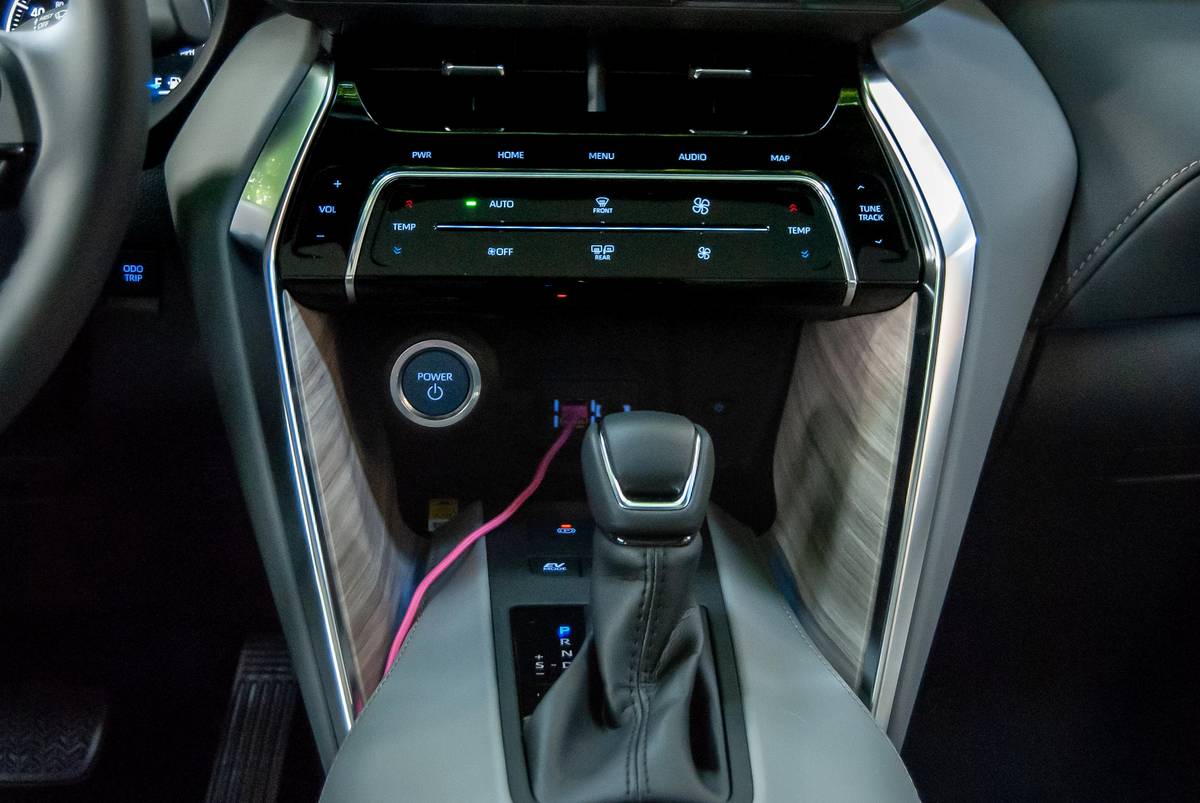
The verdict: The 2021 Toyota Venza delivers an upscale interior and a sedate driving experience that outweigh minor interior and multimedia foibles.
Versus the competition: Offering a decent mix of style and efficiency, the Venza should be competitive against the likes of the Ford Edge, Honda Passport and Hyundai Santa Fe, the top three finishers in our most recent test of two-row mid-size SUVs.
Toyota discontinued the original Venza — a Camry-based two-row crossover SUV — after the 2015 model year. For 2021, the automaker has resurrected the Venza name … on a Camry-based two-row crossover SUV. But this Venza is a hybrid. And the hybrid-only Venza (other markets get other engine choices, but in the U.S. it’s hybrid or nothin’) is also exclusively all-wheel drive and should start arriving at dealerships this summer.
Related: Here Are the 10 Cheapest New SUVs You Can Buy Right Now
I drove pre-production versions of both the XLE and Limited trim levels around Chicago and into central Illinois. (An entry-level LE trim that I didn’t experience will also be available.)
Looks the Part
The last Venza was generally considered a bloated wagon, and while the current Venza isn’t the Camry wagon enthusiasts want (but wouldn’t buy), it’s probably what we deserve. It’s a much better execution of the car-based SUV or crossover (Toyota calls it a “crossover utility vehicle”).
The new Venza looks the part of a premium SUV, and it took my eyes a day or two to remember this was a Toyota and not a Lexus. I’m personally a fan of the looks — as was a gentleman driving a third-generation Chevrolet Cavalier with flames painted on the sides, who slowed down in traffic to give me a thumbs up while I was parked. Your mileage may vary. In terms of physical proportions, the Venza is somewhere between a Lexus NX and RX.
Interior
That Lexus comparison was intentional, by the way. This is one of the nicer Toyota interiors I’ve seen in a long while, and I suspect it may keep some buyers from making the leap to a Lexus, Toyota’s premium brand. Materials are nice, particularly the blond wood accents on the doors and center console of the Limited, though quality does take a dip below eye level. Padding could also be more substantial, but at least most touch points aren’t hard plastic.
The front seats are nicely sculpted and fit adults of varying sizes, and the backseat has enough legroom and headroom for me to sit comfortably behind myself (I’m 6-foot-1), though I’d prefer the seat bottom be a little higher to keep my knees less bent for longer drives.
The Limited trim level I tested came with Toyota’s optional Star Gaze roof, an electrochromic glass panel that switches between transparent and translucent at the touch of a button. It’s a neat trick and in transparent mode makes the cabin feel even more spacious, but it can’t be opened. Toyota hasn’t told me yet whether or not the Star Gaze roof would be more expensive to repair or replace than a traditional moonroof, but I think I’d prefer the option to let in more light and air. The Star Gaze roof isn’t available in the XLE trim, but I didn’t notice a significant increase in headroom without it.
Touch-sensitive climate and audio controls can be frustrating as the only feedback they offer is audible, and the icons can be difficult to see depending on lighting conditions. The icons light up when the headlights turn on, but I found while driving that sometimes the automatic headlights would take long enough to turn on that I was left with an effectively blank panel.
The interior uses its space poorly in some instances. Controls like the electric parking brake switch and drive mode selector are positioned behind the gear selector and can be hard to reach, and beyond that is a deep but cramped cubby with USB ports and a wireless charging pad. Trying to plug in a USB cord while driving safely was impossible for me, and I’m a millennial.
The cargo area is spacious but lacks amenities. Underfloor storage is mostly taken up by a doughnut spare tire, and there aren’t any nifty cargo nets or multitiered organizational systems. It’s not that those are glaring issues or deal-breakers, but in a crowded field of two-row SUVs, little details like that tend to stand out.
Screen Real Estate Wasted, Too
The Limited features Toyota’s latest 12.3-inch multimedia touchscreen, which is optional on the XLE. An 8-inch touchscreen, Apple CarPlay, Android Auto and Amazon Alexa connectivity are standard.
Unfortunately, as we’ve seen with this giant screen in the new Highlander, the screen only dedicates roughly two-thirds of the display to a single function, using the other third for things like climate control or audio information. An icon makes it appear like you can collapse that small area to devote the full screen space to a main function, but it only switches whether the small area is on the left or right of the screen. It’s frustrating, and it’s another missed opportunity.
Boring to Drive (But That’s Good Here)
The Venza features standard all-wheel drive, but a less traditional version where the 2.5-liter four-cylinder gas engine plus the Toyota Hybrid System’s standard two electric motor-generators power the front wheels while a third electric motor powers the rear wheels. Toyota says up to 80% of the Venza’s torque can be applied to the rear wheels as needed. Total system output is 219 horsepower; while that might seem low for an SUV of this size, the power is more than adequate to get the Venza going from a stop, merge onto a busy highway and provide passing power when needed. Despite all of this, Toyota still estimates the Venza will return a 39 mpg combined rating (official EPA figures haven’t been released at the time of writing). During my driving time, I consistently observed fuel economy readings in the 30-plus mpg range, and I wasn’t trying to maximize efficiency.
Unfortunately, the continuously variable automatic transmission has a rubber-band feel under acceleration, and switching from the Normal driving mode to Sport or Eco mode just makes that feeling more glaring. Moving the gear selector into the transmission’s “S” position also exacerbates things. I kept everything in Normal for most of my driving experience as that was the most pleasant.
Besides the transmission behavior, another Toyota hybrid tradition is a spongy and vague brake pedal feel, and that’s present in the Venza, too. The stopping power is there, but the feeling takes some getting used to, particularly when stopping from higher speeds.
Steering feel is just fine, not unnecessarily heavy or noticeably overboosted. It’s not extremely communicative, but this is a hybrid SUV, so it’s enough — certainly enough to feel the Bridgestone Ecopia tires start to lose grip, which they’re happy to do in more aggressive cornering. Toyota chose them for efficiency, not road-holding, and it shows.
Ride quality is slightly harsher than I would prefer in a sedate SUV, though the Venza does a decent job of keeping the cabin isolated from significant bumps and imperfections. I also noticed more wind noise than I’m used to, particularly at highway speeds. That could be influenced by the fact that this is a preproduction model or that Toyota’s stated noise abatement steps have reduced the usual sound from other factors (engine, tires and road, for example), leaving me to hear more of the wind. And speaking of noise, the whirring electronic noises Toyota uses in its hybrid cars at low speeds to warn pedestrians continue in the Venza, and they do a good enough job of replicating an emergency vehicle’s siren that I found myself looking around to see if I needed to get out of the way or pull over. I imagine one would get used to that over time.
One feature I couldn’t test thoroughly during my short time with the Venza is what Toyota calls Predictive Efficient Drive. When enabled, Toyota says it uses the built-in navigation system to learn routes and traffic conditions and help reduce energy consumption. The Venza also features an EV mode that lets drivers use only the electric motors to move the car, but it works only for a very short time at very low speeds and, as in other Toyota hybrids, remains nearly pointless.
Safety, Standard
The Venza includes Toyota’s Safety Sense 2.0 suite of advanced safety features as standard equipment, including adaptive cruise control, lane departure warning with lane keep assist and lane-tracing assist, forward collision detection, automatic emergency braking with pedestrian detection and daytime bicyclist detection, and more. Those features work well without being overly sensitive, obtrusive or otherwise hampering the driving experience, and the semi-autonomous lane-tracing feature — other manufacturers call it lane-centering — was welcome during highway driving.
As the Venza is a new vehicle, crash-test ratings from either the National Highway Traffic Safety Administration or Insurance Institute for Highway Safety are not yet available.
Maybe Venza Means Value?
Pricing for the Venza starts at $33,645 for an LE (including a $1,175 destination fee) and tops out at $43,525 for a fully loaded Limited in a “special” paint color. That’s not quite the value proposition of a Hyundai Santa Fe, but a specced-out Venza would’ve been the second cheapest SUV in our past mid-size SUV comparison, and I have a feeling it wouldn’t finish in the back of the pack.
Whether that value translates to sales success in a crowded field — or if it mostly ends up poaching sales from Toyota’s other hybrid SUVs, the RAV4 Hybrid and Highlander Hybrid — remains to be seen. But if you’re looking for a comfortable, efficient SUV, add the Venza to your list.
Cars.com’s Editorial department is your source for automotive news and reviews. In line with Cars.com’s long-standing ethics policy, editors and reviewers don’t accept gifts or free trips from automakers. The Editorial department is independent of Cars.com’s advertising, sales and sponsored content departments.
































































































.png)



